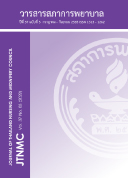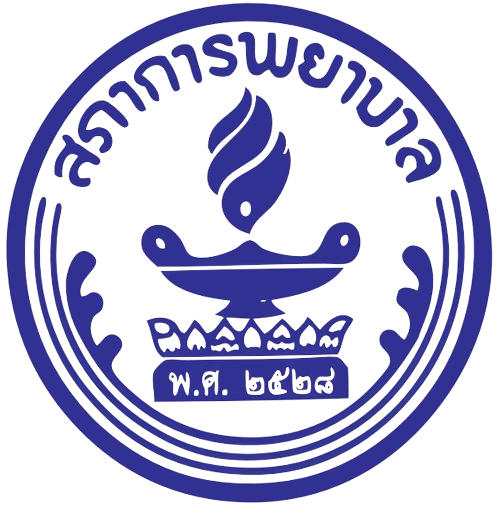Development of Integrated Discharge-Planning Programme for Stroke Patients
Keywords:
integrated discharge-planning programme, family caregivers, stroke patientsAbstract
Objective: To develop a discharge-planning programme for internal medicine stroke patients, and to assess two aspects of the programme outcomes, namely, the caregivers, in terms of caregiving preparedness, direct care-induced stress, and quality of life, and the patients, in terms of preventable complications and need for re-admission
Design: Research and development
Methodology: This study was conducted between October 2021 and June 2022 in four stages: 1) analysis of discharge-planning situation; 2) development of an integrated discharge-planning programme for stroke patients, based on Naylor’s theory of transitional care; 3) trial of the developed programme on two pairs of patients and caregivers, followed by evaluation of outcomes and adjustment of the programme for increased reliability; and 4) utilisation of the adjusted programme and final outcome assessment.
The research was designed as a two-group quasi-experimental study with a post-test. The participants were 30 pairs of stroke patients and their caregivers selected based on the inclusion criteria and equally assigned to a control group and an experimental group, 15 pairs in each. Whilst the control group received the standard discharge plan, the experimental group participated in the researcher-developed integrated discharge-planning programme.
Data were collected from the caregivers and the patients. The data from the caregivers were collected through a personal information form, the preparedness scale, the direct care-induced stress scale, and the quality of life scale. The data from the patients were collected through a personal information form, the preventable complication scale, and the re-admission records. The data were analysed based on frequency, percentage, mean, chi-square statistics, and T statistics.
Results: The caregivers in the experimental group achieved significantly higher mean scores on caregiving preparedness and pre-discharge quality of life than those in the control group did (p < .05). However, the two groups’ mean score on direct care-induced stress did not differ significantly (p > .05). One month after discharge, the experimental group also achieved significantly higher mean scores on caregiving preparedness and pre-discharge quality of life than the control group did (p < .05), and displayed a significantly lower level of direct care-induced stress than the control group did (p < .05). As for the patients, neither the experimental group nor the control group displayed any complications. Whereas two of the patients in the control group were re-admitted, none of those in the experimental group was.
Recommendations: It is recommended that hospitals have a policy to apply this integrated discharge-planning programme to treating internal medicine stroke patients, to promote their caregivers’ caregiving preparedness and quality of life.
Downloads
References
Centers for Disease Control and Prevention (CDC). Prevalence of stroke: United States, 2006–2010. MMWR Morb Mortal Wkly Rep 2012;61:379–82.
Division of strategy and planning, Office of the permanent Secretary, Ministry of public health. Reported public health status of Thailand 2020. Bangkok: the printing office to assist veterans organization; 2020.
Division of Information, MahasarakhamHosipital. Reported data of patients with stroke 2021.Mahasarakham: the printing office to assist veterans organization; 2021.
Division of non-communicable diseases, Department of Disease Control. Ministry of public health. Reported number and rate of inpatients with stroke. Bangkok: the printing office to assist veterans organization; 2018. Available from: http://www.thaincd.com/2016/ mission/documents-detail.php?id=13684&tid= 32&gid=1-020
Chuyingsakultip N, Chanchai A, Gadudom P, Kaewdang K. Quality of life of acute ischemia stroke patients in the stroke unit, Rayong Hospital. Journal of Phrapokklao Nursing College 2016; 27: 54-64. (in Thai)
Yubolchit N, Praekhao C, Tiamkao S. Quality of life of acute ischemia stroke patients in middle secondary hospital in health region 7. North-Eastern Thai Journal of Neuroscience 2019; 14: 15-36. (in Thai)
Chayawatto C. Depression in the caregivers of stroke patients.Region 4-5 Medical Journal 2016; 35: 14-27. (in Thai)
Naylor M, Shaid EC, Carpenter D, Gass B, Levine C, Li J, et al. Components of comprehensive and effective transitional Care. J Am GeriatrSoc [internet]. 2017 [cited 2021/11/9].65;1119-1125. Available from: https://www.researchgate.net/publication/ 315776473
Moonthee W, Mongkong S,Sirapo-ngam Y, Leelacharas S. Effect of transitional care program for stroke patients and family caregivers for patient’s activities of daily living, complication and satisfaction. Thai Journal of Nursing Council 2016; 31: 133-48. (in Thai)
Polit DF and Hungler BP. Nursing research: principles and methods. 6th ed. Philadelphia: J.B. Lippincott; 1999.
Archbold PJ, Stewart BJ. Family Caregiving Inventory [Unpublished manuscript]Portland: Oregon Health Sciences University; 1986.
Wirojratana V. Development of the Thai family care inventory [Doctoral dissertation, Portland: Oregon Health &Science University; 2002.
Boonchuwong O, Saneha C, Pinyopasakul W, Nilanont Y. Factors influencing readiness of caregivers of patients with stroke before hospital discharge. Journal of Nursing Science 2017; 35: 46-5. (in Thai)
Sutthilak C, Wirojratana V, Puwarawuttipanit W, Cheewakriengkrai L. Factors predicting health status on caregivers of elderly people with dementia. Journal of The Royal Thai Army Nurses 2018 ; 9: 191-99.(in Thai)
Mahatnirankul S. Comparision of the World Health Organization’s quality of life survey, a set of 100 indicators and 26 indicators. Chaingmai: Suanprung Psychiatric Hospital; 1998.
Nakasuwan V. The effectiveness of health promotion program for the elderly on the quality of life in the community. Journal of The Police Nurses 2020 ; 12: 171-80.(in Thai)
Neurological Institute of Thailand. Clinical nursing guideline for stroke. Bangkok: Tanapress; 2016.
Piumboriboon K, Pongcharoen C. Development of care model for stroke in ChoaprayaYommaraj Hospital at Supanburi. Nursing Journal of The Ministry of Public Health 2018 ; 19: 191-99. (in Thai)
Bamrasnaradura Infectious Diseases Institute. Guide to diagnosis of infections in hospitals. Bangkok: Aksorngraphic & desing; 2018.
Haesler E, et al. Prevention and treatment of pressure ulcers: reference guidelines [internet]. 3nd ed. EPUAP/ NPIAP/PPPIA: 2019[cited in 2022 March 29]. Available from: https://www.epuap.org/wp-content/ uploads/2021/04/qrg-2019-thai-04-21.pdf
Paksee N, Sirapo-ngam Y, Monkong S, Leelacharas S. Effect of transitional care program for stroke patients and family caregivers on caregiver’s preparedness, stress, adaptation and satisfaction [Dissertation]. Bangkok: Mahidol University; 2015.
Pongcharoen C, Maneewong J. The effects of preparing program on readiness among hemorrhagic stroke patient caregiver before discharge at Chaophara Yommaraj Hospital, Suphanburi. Nursing Journal of The Ministry of Public Health 2013 ; 21: 58-70. (in Thai)
Towanabot S, Hanchaiphiboolkul S, Tantirittisak T, Termklinchan T, Laoratanasaeng L, Traicharoenwonr J. Stroke. In: Makornsan S., editor. Thailand medical service profile 2011-2014 [internet]. 1st ed. Bangkok: Department of Medical service; 2014 [cited 2020 July 7]. Available from: http://training.dms.moph.go.th/rtdc/article/2
Siriyong W. Prevalence of stroke and stroke risk factors in Kanchanadit Hospital. Region 11Medical Journal 2018; 32: 863-70. (in Thai)
Tiamkao S. Controlling high blood pressure in stroke patients. North-Eastern Thai Journal of Neuroscience 2021; 16: 14-20.(in Thai) 26. Budratana S. Effects of discharge preparedness program among primary caregivers of patients with ischemic stroke in NongBuaLamphu Hospital. Nursing, Health, and Education Journal 2020; 3: 56-64. (in Thai)
Riablershirun S, Kespichayawattana J. Theeffect ofproblem solving approach program on stress of family caregivers taking care of elderly stroke survivors. Journal of The Police Nurse 2018; 10: 21-9. (in Thai)
Shyu YL,Kuo LM, Chen MC and Chen ST. A clinical trial of an individualised intervention programme for family caregivers of older stroke victims in Taiwan. Journal of Clinical Nursing [Internet]. 2010 [cited 2022 July 23]; 19:1675-85. Available from: https:// onlinelibrary.wiley.com/doi/abs/10.1111/ j.1365-2702.2009.03124.x
Kensakoo T, Sinumpaisit T, Srithumsuk W. The effectiveness of discharge planning’s clinical nursing practice guideline on activity daily livings, hospital readmission and quality of life in ischemic stroke patients. Journal of The Royal Thai Army Nurses 2020; 21: 215-24. (in Thai )
Downloads
Published
How to Cite
Issue
Section
License
Copyright (c) 2022 Thai Journal of Nursing Council

This work is licensed under a Creative Commons Attribution-NonCommercial-NoDerivatives 4.0 International License.








